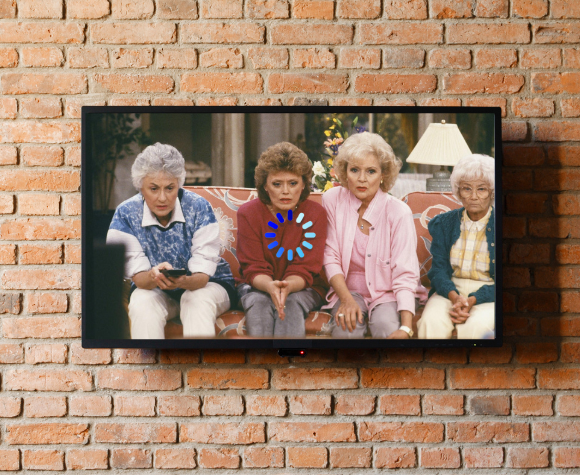Buffering Like It’s 1985
 Get ready for it, today is going to be filled with 80’s references to help point out some good things to know when it comes to streaming and buffering.
Get ready for it, today is going to be filled with 80’s references to help point out some good things to know when it comes to streaming and buffering.
I’m going to start with one of my favorite 80’s sitcoms: The Golden Girls. Now with the power of Artificial Intelligence (AI) and a creative mind, here are a few reactions we’d expect if these ladies were dealing with buffering while trying to watch their favorite show:
- Dorothy: “Oh perfect. Now my buffering screen is mocking me, I didn’t think it was possible for technology to be as frustrating as my ex-husband, but here we are.”
- Rose: “Is it supposed to do that? Maybe the internet needs to stretch its legs like a St. Olaf cow after a long winter hibernation!”
- Blanche: “This is intolerable. Do you know how hard it was to stay in the mood when a scene freezes right before the shirtless cowboy walks in?”
- Sophia (definitely my favorite response): “Back in my day, if a show stopped, it was because the rabbit ears broke, not because some invisible ‘cloud” needed a coffee break. Picture it: Sicily, 1922. We didn’t have TV. Problem solved.”
Hope that walk down memory lane gave you some good laughs, but the point was to let you know technology continues to advance and with advancement comes lots more complexities. Just think back to when you had a simple CRT (cathode ray tube) Television. It just seemed to work without buffering.
Why?
- Analog Signal Transmission – CRT TVs relied on analog signals. These signals were continuous and didn’t’ require processing or decoding in the way digital streams do.
- There was no need to download or cache data. The signal was displayed in real-time as it was received versus streaming that typically cache data to ensure smooth playback and compensate for any potential disruptions in the data transmission.
- The TV signal quality depended on the strength of the cable connection, not data packets traveling through a network
- Simpler Technology – CRT TVs were designed to display whatever signal they received instantly, without the need for advanced processing, compression or decompression
- Constant Bitrate – The analog signal transmitted a constant stream of video and audio at a fixed quality. There was no variability in resolution or bitrate as seen with modern adaptive streaming, which requires a buffering period to adjust to changing network conditions
This boils down to previous technology being much simpler. While we can agree that things in the 80’s may have been simpler, we now live in a much different world.
Which brings me to my next set of points: things are complex.
That’s right, I said it. Things are more complex. If you don’t believe me, then why have we seen the rise in extended warranties? So, for my next funny commercial break, here is a quick 80’s call AI helped to generate for an extended warranty:
“Hi this is your car’s extended warranty calling. We’ve been trying to reach you since the stone age. Your Flintstone car is out of warranty, and we’d like to offer rock-solid coverage.”
So, here’s a quick history lesson the on the growth of the “extended warranty.”
In the 50s and 60s, the concept of the extended warranty emerged due to the rapid growth of household appliances like refrigerators, washing machines and televisions. Manufacturers began offering extended warranties to reassure consumers about reliability as these products became more complex.
In the 70s and 80s, the growth of consumer electronics such as VCRs and personal computers fueled the demand for extended warranties.
By the 90s extended warranties became a standard offering in many industries, including automobiles, electronics and home appliances.
Fast forward to present and extended warranties are mainstream, widespread and have even moved to offer damage protection for smartphones and laptops. So why this increase? Simple answer, no pun intended, things are more complex.
So, I wanted to bring this all the way back around to explain why it isn’t always the Internet’s fault if you start buffering while you are streaming.
Remember Ferris Bueller’s famous question: “The question isn’t ‘what are we going to do. The question is what aren’t we going to do?”’
While Ferris often got away with everything he did and didn’t take responsibility playing the “it’s not my fault” card, often with streaming and buffering internet is the first to blame. Sometimes it may be justified, but often there are several other factors we need to consider because things are just more complex.
Those can include:
- Server Issues on the streaming platform. Streaming services can experience outages, server overloads or maintenance that may impact performance.
- Device Compatibility: Outdated apps, unsupported operating systems, older hardware or even newer hardware with limited capacity can cause streaming issues.
- App-Specific Bugs: Streaming apps might have bugs or glitches that cause content to fail to load or buffer unnecessarily.
- Network Congestion in the Home: Slow performance may stem from multiple devices competing for bandwidth and not be an issue with overall internal quality.
- Cache and Cookies: Accumulated cache and cookies on browsers or apps can interfere with streaming. Clearing these can improve playback performance.
So simply put, there are times that buffering may be cause by many other issues versus your Internet connection. I often like to use the example of a light bulb that has gone out. Is the first reaction when this happens to say the power is out or do you check other lights to see if they are working?
Similar with your streaming. If you encounter buffering, check the internet connection on other devices to see if they are working. If they are, then the problem could be one of the above-mentioned items you can check.
Can’t go without finishing this blog with one final quote: “Marty, you’re telling me you can stream entire seasons of shows instantly? The future is now, but where we’re going, we don’t need cable!”
